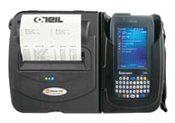Thriving In A Tough Economy
By Matt Pillar, Business Solutions magazine.
This data collection VAR survived a recession-fueled drop in revenue, then came back with a vengeance.

Mike Sweeney wondered if there was a Business Solutions cover story curse. Shortly after we published a February 2007 feature story on the success of his company, Integrated Solutions International (ISI), sales dropped significantly. Now, lest you correlate being featured in Business Solutions with a death knell, take note. Not only did ISI survive, the company closed out 2011 on record growth. Sweeney admits superstitious contemplation of the timing of the article in relation to that of his company’s drop in revenue. He also acknowledges that, in fact, two major factors contributed to the fall off, and a handful of strategic business decisions helped him pull out of it.
The Fall And Rise Of A $12 Million Integrator
In the spring of 2007, ISI was riding high on 50% growth
in the best year of its history. The business had grown significantly each year since Sweeney started it in 1992. "2007
brought with it big projects, great prospects, and high hopes,"
says Sweeney. "Then, the credit crunch and the recession
hit."
It turns out those big rollouts were one of two major causes of the downturn in business. ISI was well under way on a couple of the huge projects it was banking on that year when the recession hit hard. These were multiyear, fixed contracts with no exit clauses. When those clients stopped everything they were working on, everyone lost.
The other factor contributing to the downturn of the industry was an all-too-familiar one in the 2007/2008 time frame: the credit collapse. "We banked a lot on a mobile instant credit application that we were offering to large financial companies," explains Sweeney. It seemed a perfectly timed strategy. Banks were lending to anyone with a pulse, and consumer mobile mania was poised for explosive growth. Then, seemingly overnight, the banks stopped giving loans and started taking them. The one-two punch would have spelled disaster had ISI not first been prepared for it, then acted quickly to right the ship.
Rebuilding On A Solid Foundation
Since the founding of the company, ISI has grown liberally but
maintained its financial house conservatively. Even when sales
declined, the company never had to incur debt. "Lots of VCbacked
companies that were focused on grabbing market share
without profitability were caught off guard by the downturn,"
says Sweeney. "Our conservative approach allowed us to make
course adjustments as opposed to wholesale course corrections."
That foundation held the company up while many of its
competitors fell to pieces.
As the economy has moved slowly along in fits and starts, Sweeney has relied on the company's financial footing through the fits and capitalized on the starts. "Each indication of stabilization would yield a few projects, mainly from long-time customers who had neglected their necessary 3-to-5-year upgrade plans as long as they possibly could," he says. While the company found refuge in servicing the fundamental needs of its core customers, it also dedicated resources to the development of a business model that fit the bill for cash-strapped customers.
Retooling With Timely Solutions
Perhaps the most strategic move ISI made was restructuring
its sales model to serve the needs of an ailing customer base.
"We had to get creative in terms of our delivery and payment
structure to win projects," says Sweeney. Offering its solutions
via a managed services model softened the capital expenditures
blow for its customers.
Key application offerings at ISI are route accounting, field service, and mobile marketing, what Sweeney describes as typical outside-the-four-walls mobile communication solutions. The company's turnkey solutions include custom software and integration, hardware procurement and kitting, and deployment, application hosting, help desk, and depot services. Sweeney still contends this soup-to-nuts approach is a competitive differentiator in a space full of specialized service providers, but the up-front capital expense required of the model proved problematic in the downturn.
Traditionally, the ISI sales approach frontloaded its clients' capital expenditures. "When our customers found themselves in need of upgrades and new technologies but had little capital to expend, we took advantage of our own downtime and developed what we call Managed Solution Services [MSS]," explains Sweeney. When it engages a long-term customer, ISI develops its software and maps an integration strategy up front, before it bills the customer a dime. Then, for a monthly fee per user, ISI maintains its turnkey management of the entire solution. That monthly per-user fee includes software maintenance (updates and bug fixes, for example), several hundred hours of professional services per year, provisioning, handheld staging and configuration, and help desk and depot services. "The new model is successful because it's easier for customers to wrap their brains and budgets around a monthly fee," Sweeney says. "Depending on the services we're providing, we can offer mission-critical solutions for a price comparable to a cell phone data plan — from $25 to $75 per month per user." This has proven more than beneficial to ISI customers; it's good for the integrator's business, too. The shift has resulted in multiyear agreements and steady recurring revenue.
Tech Decisions: Pragmatism Proves Itself
When the downturn took so much work off the company's
docket, ISI took advantage of the resulting downtime and
orchestrated a road show of sorts. The
series of customer visits was conducted
for reasons far more important than
courtesy. ISI sought to learn what the
future looked like from the perspective
of a customer base that's not
only financially challenged, but which
has become increasingly intrigued by
consumer-grade devices.
"When everyone went crazy for iOS and Android and Google devices, enterprises began asking, why not?" says Sweeney. To better understand the market's desires and educate customers on their options, ISI targeted a specific set of customers across several industries, all of which were poised for upgrades. Targeted applications included direct store delivery, route accounting, and other vehicle-based, often harsh environments. ISI (which it's worth noting also develops business apps for iOS, Android, and Google devices) segmented its hardware offerings in four general categories: consumer- grade, rugged consumer-grade, light industrial, and rugged industrial. Then it packed them all up and took them on the road. "Our hardware offering spans all the major manufacturers, from ‘super phone' to ‘super rugged,' so each category featured several devices," says Sweeney.
As it met with operations, finance, and end user representatives from this cross section of its customer base, ISI dove deeply and objectively into the price points, abilities, limitations, and total cost of ownership of each class of device. "Without exception, once managers and end users were engaged with us in dialogue and hands-on demonstrations, consumer-grade device curiosity fell by the wayside," says Sweeney. On the contrary, customers' self-discovery inevitably drew them to the industrial side of the continuum, the class comprising devices like the Dolphin 99EX. "Everyone loves the iPhone, but it's made of glass. Everyone loves apps, but nobody wants a six-month upgrade cycle. Business users want screens they can read, physical numeric and alpha keyboards, one-handed/gloved-hand operation, and long-term support of the investment," he says. "When you have an opportunity to sit down with end users and gain a deep understanding of their use case, you discover they don't want less, they want more." As a result of efforts like these, Sweeney and ISI are getting more too — to the tune of 50% growth last year.

